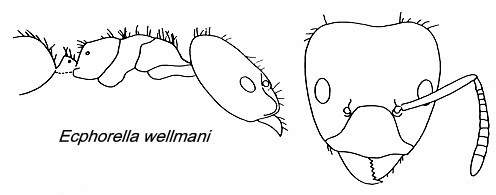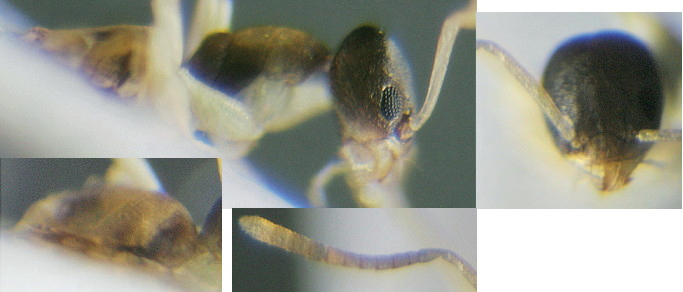SUBFAMILY DOLICHODERINAE Forel
| The Ants of
Africa SUBFAMILY DOLICHODERINAE Forel |
|
| Contents - Dolichoderinae |
Subfamily DOLICHODERINAE Forel, 1878: 364; emended spelling by Forel, 1893a: 165
Diagnostic Features - Eyes present. Clypeus developed so that antennal insertions are some distance behind the anterior margin of the head. The frontal carinae partially cover the antennal insertions. All West African genera have 12-segmented antennae. Pedicel of a single segment with a narrow connection to the gaster, such that the petiole has a distinct posterior face. The petiole usually is reduced and overhung by the first gastral segment, so that the petiole is invisible in dorsal view. No sting or acidopore, the gaster terminating in a transverse slit bounded by the pygidium and hypopygium.
In recent years, the separation into Tribes has changed from Dolichoderini and Tapinomini into the present situation held by Bolton (1995) where there is no separation and thus no need for a tribal name. Shattuck (1992) considered the Dolichoderinae and Formicinae to be sister groups.
Shattuck (1991) revised the genus Axinidris, previously regarded as monotypic with a single species, Axinidris acholli Weber, from East Africa. He transferred two other species and described ten new species, including members from West Africa. There is no modern revision of Tapinoma. Bolton (1994) had the former Engramma synonymized with Technomyrmex, although some Engramma were assigned to Axinidris by Shattuck (1991). My feeling is that the species thought by Wheeler (1922) to be Engramma but now, apparently, separated into Axinidris (Wheeler only had denticulatum) and Technomyrmex were all forms with a distinctly heart-shaped head, as seen in full-face view. See my reproduction of the Wheeler key and notes on species. Bolton (2007) has published a global review of Technomyrmex. He sustains the synonymy of Engramma but made no comments on the separation of species by the structure on the clypeus - writing (p 5) "Median portion of anterior clypeal margin transverse to very deeply incised". In his definition of species groups the form of the clypeal margin tends to be uniform in most groups.
In his keys to genera, Bolton (1994) has the Afrotropical Dolichoderinae as including two other genera, both with well developed petiole scales - Linepithema and Ecphorella.
Why Linepithema is in the key is not obvious as it is a Neotropical genus, with one listing from France (presumably imported) in Bolton (1995). It, however, was reported from the Cape area of South Africa by Arnold (1915: 145), as Iridomyrmex humilis, now Linepithema humile (Mayr). He thought it was probably introduced in forage during the Boer War and had become a major pest in houses but also all over the Cape Peninsula, apparently near-eradicating all indigenous ants below about 300 m.
Ecphorella, is a monotypic genus. The type location is
Angola, at Benguela (Tapinoma (Ecphorella) wellmani, by C.
Wellman, in Forel, 1909b: 66; raised to genus by Shattuck, 1992c: 85);
worker only described (see Bolton, 1995).
Diagnostic separation of the genera is as follows -
| 1 |  It is easily separated as the petiole scale is well
developed and the gaster is not inclined over the scale, TL 3.2-3.5 mm,
brown or blackish brown, appendages lighter to white, whole body
covered with very fine pale pubescence, longer on the gaster It is easily separated as the petiole scale is well
developed and the gaster is not inclined over the scale, TL 3.2-3.5 mm,
brown or blackish brown, appendages lighter to white, whole body
covered with very fine pale pubescence, longer on the gaster |
Genus Linepithema |
| 2 |  Monotypic genus, separable particularly by the thickened
petiole scale with a sloping anterior face, with one species wellmani
(Forel) Monotypic genus, separable particularly by the thickened
petiole scale with a sloping anterior face, with one species wellmani
(Forel) |
Genus Ecphorella |
| 3 |  With low but distinct petiolar node; propodeum with a pair
of teeth, tubercles or acute angles posterolaterally; sometimes linked
by a distinct lateral carina; in midwidth the propodeum has a raised
area - ranging from a simple ridge to a prominent tooth; propodeal
spiracles dorsally placed With low but distinct petiolar node; propodeum with a pair
of teeth, tubercles or acute angles posterolaterally; sometimes linked
by a distinct lateral carina; in midwidth the propodeum has a raised
area - ranging from a simple ridge to a prominent tooth; propodeal
spiracles dorsally placed |
Genus Axinidris |
| 4 |  Petiolar
node absent; propodeum unarmed, propodeal spiracles ventral and near
hind coxae; in dorsal view, gaster with only four visible segments; the
fifth segment facing ventrally (many species have thin cuticles and the
gaster and head often collapse on mounting) Petiolar
node absent; propodeum unarmed, propodeal spiracles ventral and near
hind coxae; in dorsal view, gaster with only four visible segments; the
fifth segment facing ventrally (many species have thin cuticles and the
gaster and head often collapse on mounting) |
Genus Tapinoma |
| 5 | Petiole node low to nil; propodeum unarmed in dorsal view; propodeal spiracles lateral (but below the dorsum) or ventral, gaster with five visible segments, anal orifice apical | Genus Technomyrmex |
| . |  Head
shape approximately rectangular or ovoid, where impressed posteriorly
or anteriorly (the clypeal margin) the impression is no more than
shallow Head
shape approximately rectangular or ovoid, where impressed posteriorly
or anteriorly (the clypeal margin) the impression is no more than
shallow |
subgenus Technomyrmex. |
| . |  Head shape cordiform, clypeus has a distinct medial notch
with sharp corners Head shape cordiform, clypeus has a distinct medial notch
with sharp corners |
subgenus Engramma. |
Notes
Some of the specimens given code identification by Room (1971, 1975) as Tapinoma or Technomyrmex (most likely among the latter) now would be separable as Axinidris (four species) but Shattuck (1991) made no reference to any codes.
Wheeler (1922: 921) has a footnote that reads -
"Raffray (1887, Rev. d'Ent., Caen, p. 21) and Wasmann (1894,
'Verzeichen. Myrmoph. Termitoph. Arthrop.,' p. 100) mention a Bothriomyrmex
pumicatus "Rey", from the Cape Colony, evidently a manuscript name.
Moreover, no species of the genus Botrhiomyrmex is at present
known from the Ethiopian Region". Bolton (1995: 81) suggests this was
due to an error in Wasmann (1894: 100, not in HNS) in citing Bothroponera
pumicosa Ray, from Raffray (1887: 21), itself a misinterpretation
of Bothroponera pumicosa [now Pachycondyla
(Bothroponera) pumicosa].
Engramma
Most of the following information is taken from Wheeler (1922) for Engramma - since entirely revised and re-ordered by Shattuck (1991, 1992b) with most species removed to Technomyrmex and E. denticulatum to Axinidris.
My feeling is that the Engramma, now Technomyrmex, were orginally separated as having a head which is distinctly heart-shaped in full-face view. Wheeler (1922) defined the workers of Engramma as:- Small, monomorphic, with the head more or less excised behind, and the anterior border of the clypeus semicircularly notched in the middle and posteriorly extending back between the short but widely separated carinae. Maxillary palps 4-segmented. Antennae 12-segmented, with long first and last funicular joints. Gizzard with narrow, separated, anchor-like sepals. Gaster large, its first segment overlying the petiole; anus terminal or subterminal.
Forel's (1905b) definition of Engramma was of the male but
was accompanied by the description of the new species (now) Technomyrmex
lujae; this is at ![]() .
.
The genus, as thought in 1922, had been known only since 1910 and comprised six described species. It has a very narrow range, being confined to equatorial Africa and in all probability to the forest regions. Most of the species evidently live in the cavities of myrmecophytes. According to Wheeler, at least one, however, lives in the ground (wolfi) and another, zimmeri subspecies okiavoŽnsis of the Congo, had been found inhabiting "a large pale gray nest, soft, woven and mixed with fine vegetable matter and applied to the trunk of a tree."
|
© 2007, 2008, 2010, 2013 - Brian Taylor CBiol FSB FRES 11, Grazingfield, Wilford, Nottingham, NG11 7FN, U.K. |
href="dolichoderinae.htm"